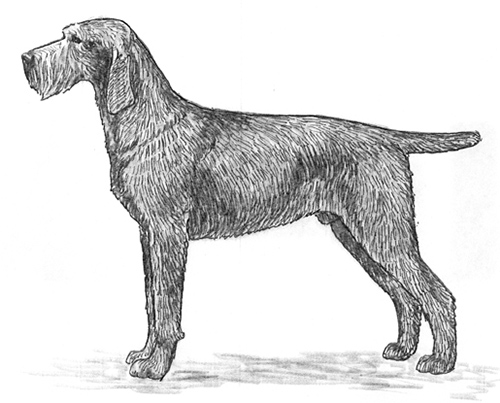Slovakian Wire-Haired Pointing Dog
Gun Dog Group
The goals and purposes of this breed standard include: to furnish guidelines for breeders who wish to maintain the quality of their breed and to improve it; to advance this breed to a state of similarity throughout the world; and to act as a guide for judges.
Breeders and judges have the responsibility to avoid any conditions or exaggerations that are detrimental to the health, welfare, essence and soundness of this breed, and must take the responsibility to see that these are not perpetuated.
Any departure from the following should be considered a fault, and the seriousness with which the fault should be regarded should be in exact proportion to its degree and its effect upon the health and welfare of the dog and on the dogs ability to perform its traditional work.
History
The Slovakian Wire-Haired Pointing Dog is a Continental type Braque breed that originated in Slovakia. The breed is used to point and retrieve game from land and water.
The Slovakian Wire-Haired Pointing Dog was recognized by the United Kennel Club in 2006.
General Appearance
A harsh coated, medium sized working breed that is slightly rectangular in shape and solidly built, but not coarse or heavy.
Characteristics
Obedient and easy to train.
Head
The head is fairly long and lean, with tight skin.
SKULL
The skull is rectangular in shape. The superciliary arches must be pronounced. The frontal furrow is visible, but the occipital bone is felt upon touch, not protruding. The stop is moderate.
MUZZLE
The muzzle is the same length as the skull, and sufficiently wide with a strong underjaw and moderately developed, close fitting, dark lips.
TEETH
The Slovakian Wire-Haired Pointing Dog has a complete set of evenly spaced, white teeth meeting in a scissors bite.
Disqualifications: Overshot or undershot bite.
NOSE
The large nose is dark in color.
EYES
The almond shaped, deeply set eyes are amber in color and have an intelligent expression. In young dogs the eyes are bluish. The eyerims are dark.
Disqualifications: Entropion or ectropion.
EARS
Set above eye level, broad at the base, and rounded at the tips.
Neck
Medium length, lean and clean, the neck is set and carried high.
Forequarters
The shoulders are muscular and well-developed. The shoulder blade and upper arm meet at an angle of 110 degrees.
FORELEGS
The legs are vertical, with lean, marked musculature. The pasterns are fairly short and almost vertical.
Body
The chest is oval in shape, and let down to the elbow. The forechest is well-developed and the ribs are well sprung. The withers are well pronounced. The back is straight and slopes slightly towards the hindquarter. The croup is broad, fairly long and slightly sloping. The belly is slightly tucked up.
Hindquarters
The hindquarters are well angulated. The angle of the pelvis and femur is 80 to 85 degrees.
HIND LEGS
The thighs are broad and muscular. The stifle and hock are well angulated. The rear pasterns are nearly vertical.
Feet
Rounded in shape, with tight, arched toes. The nails and pads are dark in color.
TAIL
The tail is moderately strong and set fairly high. It is characteristically docked to half length and is carried horizontally. It is well furnished with hair, but not brush style.
Coat
The topcoat is harsh, straight and flat, and about 1 inches long. There is a short, fine undercoat that is affected by climate and season. On the lower part of the muzzle the hair is longer and softer, making a mustache. There are eyebrows above the eyes. The skull is covered with short, harsh hair and the hair on the ears is short and soft. The tail is well furnished.
Serious Faults: Coat too long or silky. Coat too short without mustache or eyebrows.
Color
The basic color is gray, with or without white markings on the chest and legs.
Serious Fault: Too pale color that fades to cream.
Disqualification: Any color other than gray.
Height
Height at the withers for males is 24.5 to 26.5 inches. For females, it is 22.5 to 25 inches.
Serious Faults: Over or under size.
Gait
Balanced and lively.
Disqualifications
(A dog with a Disqualification must not be considered for placement in a conformation event, and must be reported to UKC.)
Unilateral or bilateral cryptorchid.
Viciousness or extreme shyness.
Albinism.
Overshot or undershot bite.
Entropion or ectropion.
Any color other than gray.
The docking of tails and cropping of ears in America is legal and remains a personal choice. However, as an international registry, the United Kennel Club is aware that the practices of cropping and docking have been forbidden in some countries. In light of these developments, the United Kennel Club feels that no dog in any UKC event, including conformation, shall be penalized for a full tail or natural ears.

Looking for a Dog?
Find a dog that will fit your family.
Note: The breeders on this list are not endorsed by UKC.
©Copyright 2006, United Kennel Club
